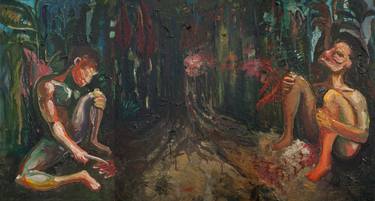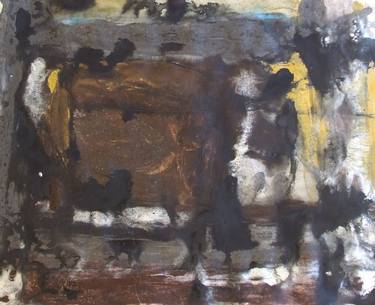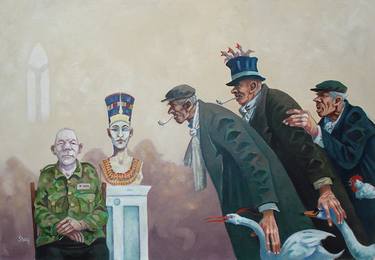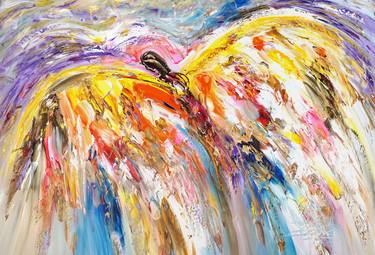- All Artworks
- Paintings
- Religious
Religious Paintings For Sale
Browse art and see similar matches
Try Visual Search
Category
Filter (1)
Other famous religious paintings include“Maesta” (1280-85) by Cimabue, an artist renowned for being one of the first to break from the two-dimensional Byzantine style; “Lamentation (the Mourning of Christ)” (1305) by Giotto; Fra Angelico’s “Annunciation” (1437-46); “Adoration of the Magi” (1481) and “The Last Supper” (1495-98) by Leonardo da Vinci.
Several ancient civilizations in the mid and far east that practiced some form of ancestor worship employed artists to produce religious paintings to venerate their deceased antecedents. These ancestor spirits were believed to possess god-like powers to help or harm their descendents. 2000-year old cave paintings of Hindu deities still grace the walls of the Ajanta Caves in Maharashtra, India, while the art of Buddhist painting proliferated in China between 317-1279 CE.
As Islamic doctrine bans the creation of figurative artwork within a religious context, both early and contemporary Islamic religious paintings feature abstract designs of symbolic religious significance and calligraphy of Quranic verses.
The oldest-known Christian paintings date to 70 CE (a time when Christian artwork was relatively rare) and were found in the ruins of Megiddo in Northern Israel. Eventually, the 4th century conversion of Roman Emperor Constantine I to Christianity would cause Christian themes to dominate western painting for the next millennia.
Christian iconography panel paintings of the Byzantine tradition were created using the encaustic painting technique (i.e. pigment with a wax binder). Artists were required to paint high-fidelity reproductions of church-sanctioned prototype images of divinities, leaving very little room for creative license.
Today, although religious paintings are still used in religious ceremonies and rituals, many contemporary painters choose to incorporate various religious elements into works both figurative and abstract, for purely aesthetic or non-ritualized inspirational purposes. For example, a religious painting of Jesus may serve as a decorative reminder of Judeo-Christian values rather than as an icon used in ceremonial worship. Furthermore, artists may create works depicting religious symbols, deities, scenes from sacred texts, etc. to communicate messages both religious and non.
Filter
Category
Style
Subject
Medium
Material
Price
Size
Orientation
Color
Artist Country
Featured Artist
Paintings, 48 W x 30 H x 1 D in
United States
$1,120
Prints from $48
Paintings, 78.7 W x 78.7 H x 0.1 D in
Switzerland
$3,390
Paintings, 19.7 W x 27.6 H x 2 D in
France
$5,450
Prints from $59
Paintings, 28.5 W x 70 H x 1.1 D in
Serbia
$22,600
Paintings, 19.7 W x 27.6 H x 2 D in
France
$5,450
Prints from $60
Paintings, 17 W x 14 H x 1 D in
United States
$430
Prints from $40
afraid of time 061220200912202010122020
Paintings, 70.9 W x 51.2 H x 1.2 D in
Czech Republic
$4,950
Prints from $100
Paintings, 18 W x 24 H x 1 D in
United States
$555
Prints from $40
Hero At Halloween Party At Cafe 1
Paintings, 17 W x 14 H x 0 D in
United States
$430
Prints from $40
two angels drinking at cumberland gap
Paintings, 24 W x 18 H x 0.1 D in
United States
$565
Prints from $52
Paintings, 18 W x 24 H x 1 D in
United States
$555
Prints from $40
Paintings, 36 W x 24 H x 1 D in
United States
$830
Prints from $48
Archangel Gabriel To Mary Annunciation. Diptych
Paintings, 10.2 W x 6 H x 0.1 D in
United Arab Emirates
$370
Paintings, 14 W x 17 H x 1 D in
United States
$430
Prints from $40
Paintings, 22 W x 30 H x 1 D in
United States
$900
Prints from $95
Paintings, 19.7 W x 27.6 H x 2 D in
France
$5,450
Prints from $73
Paintings, 15.7 W x 23.6 H x 0.4 D in
United Arab Emirates
$260
Paintings, 28.6 W x 10.5 H x 0.1 D in
United Arab Emirates
$860
Paintings, 47.2 W x 59.1 H x 0.8 D in
Germany
$11,000
Paintings, 27.6 W x 31.5 H x 0 D in
Ukraine
$2,150
Prints from $40
Paintings, 51.2 W x 27.6 H x 1.6 D in
Brazil
$2,950
Prints from $40
Paintings, 55.1 W x 55.1 H x 2 D in
$4,990
Prints from $40
Paintings, 35.4 W x 35.4 H x 1.6 D in
Netherlands
$660
Prints from $40
Paintings, 30 W x 22 H x 0.1 D in
United States
$2,170
Paintings, 30 W x 24 H x 1 D in
United States
$680
Prints from $40
One Knows Another Much More Through Art Than One Knows One Through Tangible Relationship
Paintings, 14 W x 17 H x 1 D in
United States
$430
Prints from $40
Paintings, 19.7 W x 25.6 H x 0.8 D in
Spain
$990
Prints from $100
Paintings, 12.6 W x 17.3 H x 0.1 D in
$667
Paintings, 22 W x 30 H x 1 D in
United States
$680
Prints from $40
Paintings, 17 W x 14 H x 1 D in
United States
$430
Prints from $40
"Where can I go from Your Spirit?"
Paintings, 28.2 W x 15.5 H x 0.1 D in
United Arab Emirates
$2,400
Paintings, 12.6 W x 16.1 H x 0 D in
Mexico
$270
Prints from $66
Paintings, 29.5 W x 43 H x 0.1 D in
Spain
$1,543
Prints from $40
Paintings, 40.8 W x 39.3 H x 0.1 D in
United States
$1,030
Prints from $40
Paintings, 19 W x 13 H x 1 D in
United Kingdom
$3,050
Paintings, 43.5 W x 30.5 H x 0.1 D in
United States
$1,850
Prints from $50
Paintings, 30 W x 40 H x 1.6 D in
United States
$800
Paintings, 15.9 W x 15.9 H x 2 D in
United Kingdom
$1,680
Prints from $100
Paintings, 19.7 W x 27.6 H x 2 D in
France
$5,450
Prints from $170
Paintings, 40 W x 50 H x 1.5 D in
United States
$10,600
Paintings, 8 W x 10 H x 0.2 D in
United States
$385
Prints from $40
Paintings, 24 W x 18 H x 1 D in
United States
$555
Prints from $40
Paintings, 36 W x 36 H x 2 D in
United States
$5,850
Paintings, 31.9 W x 25.6 H x 0.6 D in
Spain
$5,100
Soul in Paris (City of Lights)
Paintings, 36 W x 48 H x 1 D in
United States
$1,373
Prints from $40
Paintings, 17 W x 14 H x 1 D in
United States
$430
Prints from $40
No Ideas; Multiple Ideas; Thoughts About Thoughts
Paintings, 17 W x 14 H x 1 D in
United States
$430
Prints from $40
Paintings, 10.2 W x 9.8 H x 0 D in
Spain
$940
Paintings, 23.6 W x 23.6 H x 1.6 D in
Spain
$3,670
Paintings, 61 W x 41.3 H x 1.5 D in
Germany
$2,650

















































